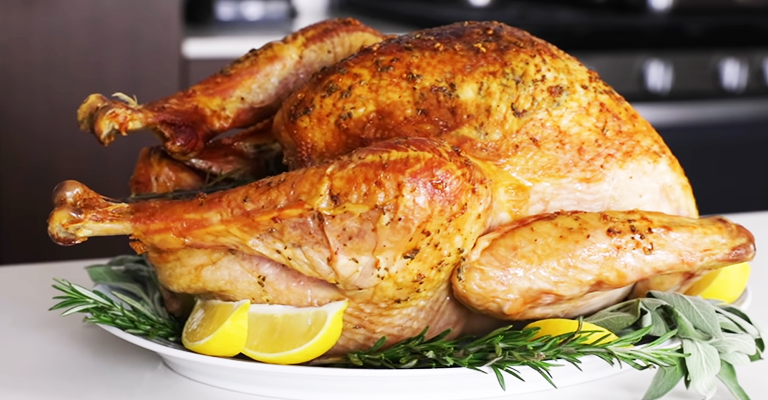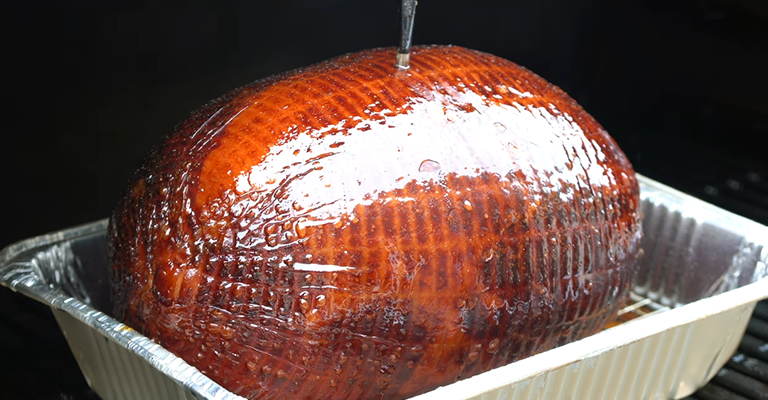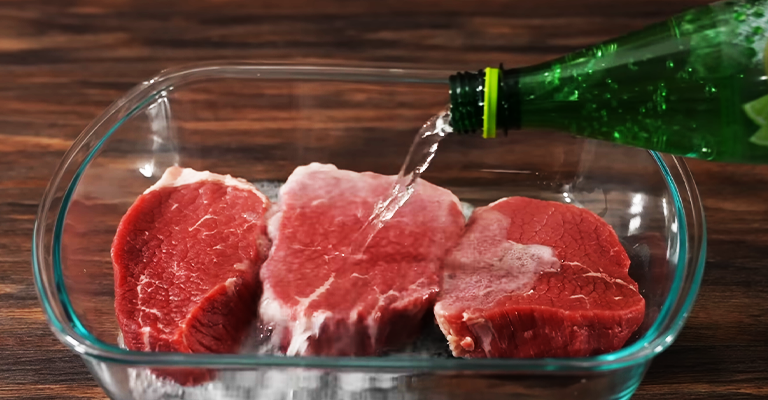Why Is My Turkey Taking So Long To Cook?
Cooking a turkey is often an exercise in patience, as the slow roasting process allows the flavors to meld, the skin to crisp, and the meat to become tender and succulent.
However, there are times when patience is in short supply, and you find yourself needing to cook a turkey quickly without compromising on taste and quality. In such situations, it’s essential to have the right techniques and strategies at your disposal.
This guide will explore the art of fast turkey cooking, revealing tips and methods to help you serve up a delicious, perfectly cooked turkey in less time than you might think possible.
Whether it’s a last-minute gathering or a time-sensitive occasion, these insights will ensure that savory and satisfying turkey dinner is well within your reach.

Why Is My Turkey Taking So Long To Cook?
Preparing a turkey can be both exciting and challenging, especially when it seems like your bird is taking longer to cook than expected.
Several factors contribute to this extended cooking time, and understanding them can help you achieve a perfectly cooked turkey. Let’s explore why your turkey might be taking longer than you anticipated:
Size And Shape Of The Bird
- Size Matters: The size of your turkey significantly influences cooking time. Larger turkeys require more time in the oven, so plan accordingly. For instance, a 20-pound turkey will take longer than a 12-pound one to cook thoroughly.
- Special Considerations: Different turkey shapes, like broad-breasted or traditional, can impact cooking. Broad-breasted turkeys have a larger breast meat-to-leg ratio, making them prone to uneven cooking.
Shielding the breast with foil during cooking can help ensure even results. Traditional-shaped turkeys are generally more consistent in cooking, but size still plays a crucial role. Using a meat thermometer is essential to monitor doneness accurately.
Frozen Or Not
Whether your turkey is frozen or not significantly affects cooking time. A frozen turkey takes considerably longer to cook as it requires extra time to thaw before cooking can commence.
It’s imperative to plan ahead and employ proper thawing methods to ensure safe and delicious results. Cooking a frozen turkey can also lead to uneven cooking, potentially risking foodborne illnesses.
Therefore, for a stress-free and safe cooking experience, always opt for a thawed turkey or plan for ample thawing time.
How Hot Your Oven Is (And Its Settings)
The temperature of your oven plays a critical role in turkey cooking time. Accurate oven heat is essential to ensure that the turkey cooks evenly and reaches the desired internal temperature.
Deviating from the recommended temperature can lead to undercooking or overcooking. Use an oven thermometer to confirm the oven’s accuracy and monitor it throughout cooking. Maintaining the correct temperature ensures that your turkey turns out succulent and safe to eat.
Moistness Of The Stuffing
The moisture level of your turkey’s stuffing can affect cooking time and the turkey’s overall moistness. Dry stuffing can absorb heat, potentially leading to overcooking or uneven cooking of the bird.
To maintain both a moist turkey and flavorful stuffing, consider cooking the stuffing separately. If you prefer stuffing inside the turkey, use a moist recipe and stuff it just before cooking to ensure it doesn’t draw too much moisture from the bird during roasting.
Liquid Fireguard
A “liquid fireguard” is a technique used in turkey cooking to enhance moisture and flavor while protecting the bird from drying out. It involves basting or brushing the turkey with flavorful liquids like broth, butter, or oil during roasting.
This not only adds moisture but also forms a protective layer that helps prevent the turkey’s exterior from becoming too dry.
Regularly applying these liquids throughout the cooking process can contribute to a juicy, delicious turkey with beautifully browned and flavorful skin.
What Do I Do if My Turkey Isn’t Cooking Fast Enough
Turkey isn’t cooking as quickly as you expected, there are several steps you can take to ensure that it cooks through safely without becoming overcooked:
Check the Oven Temperature
Ensure that your oven is maintaining the correct temperature. Ovens can sometimes run hotter or cooler than the indicated setting. Use an oven thermometer to verify the accuracy of your oven’s temperature. If it’s not at the desired level, adjust accordingly.
Patience Is Key
Cooking a turkey takes time, especially if it’s a large bird. Patience is essential. Avoid the temptation to increase the oven temperature significantly to speed up the process, as this can lead to uneven cooking and dry meat.
Shield the Turkey
If the turkey is browning too quickly on the outside but is not yet cooked through, you can use aluminum foil to shield the breast or other exposed areas. This will help prevent over-browning while allowing the bird to continue cooking.
Use a Meat Thermometer
The most reliable way to determine if your turkey is done is by using a meat thermometer. Insert it into the thickest part of the thigh without touching the bone.
The turkey is safe to eat when it reaches an internal temperature of 165°F (74°C). Keep in mind that the temperature will continue to rise slightly after you remove it from the oven due to residual heat.
Consider the Stuffing
If you’ve stuffed your turkey, the stuffing can affect cooking time. Ensure the stuffing reaches a safe temperature (165°F or 74°C) as well.
If your turkey is taking longer to cook because of the stuffing, you might consider finishing the stuffing in a separate dish while letting the turkey continue to roast.
Plan Ahead
For future occasions, plan your cooking schedule carefully. Thaw the turkey well in advance if it is frozen, and consider the turkey’s size and your oven’s cooking time. Allow extra time to rest the turkey after it comes out of the oven.
Stay Calm
It’s easy to feel stressed when your turkey isn’t cooking as quickly as you hoped, especially if you have hungry guests waiting. Remember that it’s better to serve a properly cooked, safe, and delicious turkey even if it takes a bit longer than to rush the process and risk an undercooked meal.
How Long Does It Take to Cook a Turkey?
The cooking time for a turkey depends on several factors, primarily the turkey’s weight and the oven temperature you use. As a general guideline, you can estimate the following cooking times for a turkey roasted at 325°F (163°C):
- 12 to 14 pounds: Approximately 3 to 3.75 hours
- 14 to 18 pounds: Approximately 3.75 to 4.25 hours
- 18 to 20 pounds: Approximately 4.25 to 4.5 hours
- 20 to 24 pounds: Approximately 4.5 to 5 hours
These times are approximate and can vary based on factors like oven accuracy, the turkey’s specific shape, and whether it’s stuffed or not. Therefore, it’s crucial to use a meat thermometer to determine the turkey’s doneness accurately.
The turkey is safe to eat when the thickest part of the thigh reaches an internal temperature of 165°F (74°C), and the juices run clear when you pierce the thigh with a thermometer.
Can You Stop and Restart Cooking a Turkey?
Yes, you can stop and restart cooking a turkey, but it’s important to do so safely to ensure the turkey remains safe to eat and maintains its quality. Here’s how to stop and restart cooking a turkey properly:
Stopping Cooking
- Turn off the Oven: When you decide to stop cooking the turkey, turn off the oven immediately to halt the cooking process.
- Remove the Turkey: Carefully remove the turkey from the oven. Use oven mitts or towels to protect your hands from the hot pan.
- Cover and Rest: Cover the turkey loosely with aluminum foil to help retain its warmth and prevent it from cooling too quickly. Allow the turkey to rest at room temperature for a short period, no more than 2 hours.
Restarting Cooking
- Preheat the Oven: When you’re ready to resume cooking, preheat the oven to the original cooking temperature (usually 325°F or 163°C).
- Return the Turkey to the Oven: Place the turkey back in the preheated oven. If you were using a meat thermometer, insert it into the thickest part of the thigh without touching the bone.
- Continue Cooking: Resume cooking the turkey until it reaches the desired internal temperature. Remember that you’ll need to factor in the time the turkey was out of the oven when estimating the remaining cooking time.
- Check Doneness: Use a meat thermometer to confirm that the turkey’s internal temperature has reached 165°F (74°C) in the thickest part of the thigh. Ensure that the juices run clear when you pierce the thigh with the thermometer.
- Rest and Serve: After the turkey reaches the desired temperature, remove it from the oven and let it rest for about 20-30 minutes before carving and serving.
Why a Frozen Turkey Takes Longer to Cook?
A frozen turkey takes longer to cook primarily because the process of thawing the turkey is necessary before it can begin cooking properly. Here’s why a frozen turkey requires more time to cook:
Temperature Differential
When you place a frozen turkey in the oven, there’s a significant temperature difference between the frozen interior and the desired cooking temperature. The heat must first penetrate the frozen turkey’s exterior before it can start cooking the meat inside.
Heat Transfer
Heat transfer occurs gradually in a frozen turkey. As the heat travels from the outside to the inside, it melts the ice crystals within the turkey. This phase change from ice to water absorbs a considerable amount of energy before the meat can begin to cook.
Thermal Mass
A frozen turkey has a higher thermal mass compared to a thawed turkey of the same size. This means that there’s more mass to heat, which requires more energy and time for the turkey to reach a safe internal temperature.
Uneven Cooking
Cooking a frozen turkey can lead to uneven cooking because the exterior of the turkey may become overcooked or dry while the interior is still thawing and cooking. This can result in a less desirable texture and flavor.
Tips for Turkey Fast Cooking
Cooking a turkey quickly while ensuring it’s still moist and flavorful can be challenging, but it’s possible with some strategic cooking methods. Here are tips for fast-cooking a turkey:
Choose a Smaller Bird
Smaller turkeys cook faster. Opt for a turkey that’s appropriately sized for your gathering to reduce cooking time.
Spatchcock Turkey
Spatchcocking involves removing the backbone and flattening the turkey. This technique allows for even cooking and reduces cooking time significantly.
Use a High Temperature
Roasting the turkey at a higher temperature, such as 425°F (220°C), can speed up cooking. This technique can yield crispy skin while reducing overall cooking time.
Butterfly Turkey
Similar to spatchcocking, butterflying involves cutting the turkey open and flattening it. This method ensures even cooking and reduces the time needed.
Use a Convection Oven
If available, a convection oven with a fan can cook a turkey faster than a conventional oven. It promotes even heat circulation.
Brine or Inject
Brining or injecting the turkey with a flavorful solution can help keep the meat moist during fast cooking.
Cook in Pieces
Consider cooking turkey pieces (e.g., turkey breast, legs, and wings) separately instead of a whole turkey. This can significantly reduce cooking time.
Use a High-Quality Meat Thermometer
A reliable meat thermometer is crucial for ensuring the turkey is cooked to the safe internal temperature of 165°F (74°C). Check the temperature in multiple spots to confirm doneness.
Carve Before Roasting
Pre-carve the turkey into individual pieces, such as breasts, legs, and wings, and roast these pieces separately. This can cut cooking time significantly.
Baste and Seal
Basting the turkey with melted butter or oil during cooking can help retain moisture. Cover the turkey with foil for part of the cooking time to seal in juices.
FAQs
Can I stuff a turkey if I’m short on time?
While it’s possible to stuff a turkey, it can significantly increase cooking time. If you’re short on time, consider cooking the stuffing separately for faster results.
What’s the minimum resting time for a turkey?
A turkey should rest for at least 20-30 minutes after cooking. This resting period allows the juices to redistribute, resulting in juicier and more flavorful meat.
Can I use a slow cooker to cook a turkey quickly?
Slow cookers are designed for low and slow cooking, making them unsuitable for quickly cooking a turkey. They won’t achieve the desired crispy skin and may not reach the safe internal temperature fast enough.
What’s the best way to carve a turkey quickly?
To carve a turkey quickly, start by removing the legs and wings, then slice the breast meat. Carving before serving can save time and make it easier to distribute the meat.
How do I speed up the thawing process for a frozen turkey?
The safest way to thaw a turkey quickly is by using the cold water thawing method. Submerge the turkey in cold water, changing the water every 30 minutes. This method can take 30 minutes per pound to thaw.
To Recap
The art of fast turkey cooking is akin to having a trusty ace up your sleeve. While traditional turkey preparation may be a labor of love, the need for speed sometimes arises, and knowing how to navigate this culinary challenge can save the day.
From selecting smaller birds to innovative cooking techniques, we’ve explored the avenues of efficiency without sacrificing flavor and moistness.
In the grand finale, it’s crucial to remember that the goal is not just a swiftly cooked turkey but one that delights the taste buds and brings people together.
With the right techniques and a dash of creativity, you can confidently serve up a succulent, fast-cooked turkey that leaves everyone at the table satisfied and impressed.
So, whether it’s a spontaneous gathering or simply a desire for a quicker feast, embrace the art of fast turkey cooking with enthusiasm, and savor the delicious results.

